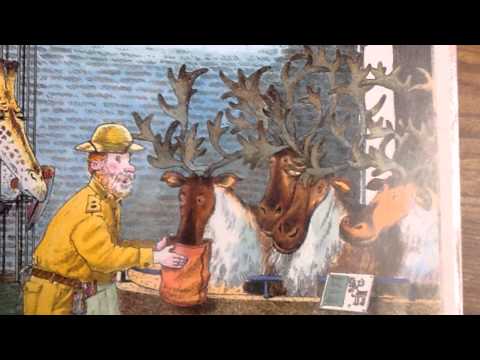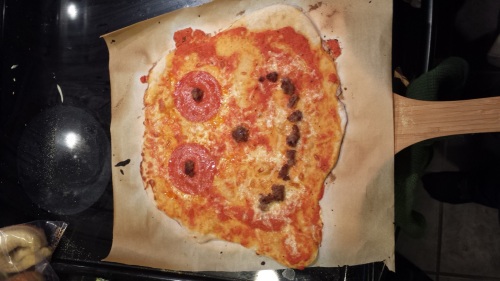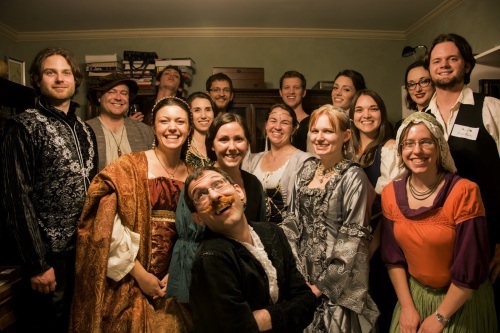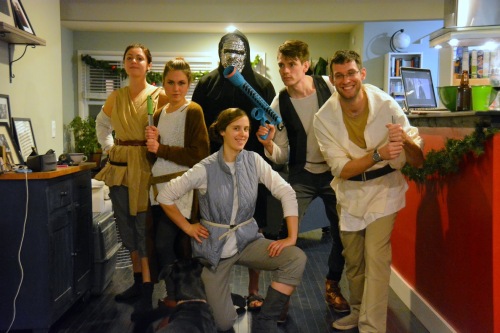 It’s here! It’s here! Fantastic Beasts is here! But does it hold up to the exceptional standards of creativity Potter fans crave?
It’s here! It’s here! Fantastic Beasts is here! But does it hold up to the exceptional standards of creativity Potter fans crave?
Yes and no.
As a die-hard Harry Potter Fan, my hopes were high with this prequel series. My overall takeaway is that Fantastic Beasts is a good—not great—film that sets up sequential films and plot lines nicely.
As it is difficult to speak about this film without giving away spoilers, I will share the non-spoiling bits first, and then alert those of you who haven’t seen it yet before launching into specific plot points.
NON SPOILER REVIEW
Fantastic Beasts takes place in 1920’s New York and, boy, does that come across well. I love the grunge and the cramped spaces and the hard times mingled with a sense of possibility. The look-and-feel of the film pulls you in from the start. You want to soak up the period atmosphere and all that comes with it. It really is a shame that the camera moves so quickly; you barely get to see any of the detail in each shot. For example, the opening montage of newspapers flies by so fast you can barely read the headlines—and you may even get nauseous in the attempt. Even so, my imagination was pricked by what I caught, and I grew even more curious about what the Wizarding world in America had in store.
The film follows the path of Newt Scamander, an English ex-Hogwarts student who arrives via steamship with a mysterious suitcase containing a wide collection of magical creatures. Almost immediately, chaos ensues, beginning with the escape of the wily niffler which, as we learn from Hagrid’s Care of Magical Creatures class in the Harry books, is attracted to shiny, valuable objects. The audience giggled along with the niffler’s antics, watching it stuff the contents of a bank safe into its little pouch. I approve of the niffler design, a distinction I take seriously being married to a character designer. I likewise approve of many of the other creatures in design, though their CG animation often seemed forced and cheap. You’d think after all of the disastrous Star Wars prequels that Hollywood would have learned not to forgo props and puppets in lieu of pure CG, but alas. Many of the interactions with the fantastic beasts looked off, lacking in texture and weight, a shiny creature juxtaposed with the gritty city background. When the actors “touched” the creatures, it simply failed to look at all real. It’s like watching TV dramas where people hand each other coffee cups that are clearly empty: we knew the Fantastic Beasts actors weren’t really holding anything, let alone funky bird snake things.
To speak generally of the story, I most appreciated the suspense created; I definitely needed to find out what and/or who the mysterious “Obscurus” was. Many of the characters, especially Newt and Graves, had a mystique that drew me in. That said, many of the other characters could have been better developed, particularly Tina, Queenie, and Jacob. Like many of the later, original Harry Potter films, subtlety of character, plot, and what I will call “world establishing” is lost to action sequences and flashy special effects. This is a shame, as anyone who enjoys the books knows that it is the characters who drive the story, not the flash-bang magic they produce. I would have liked very much to know more about all of the characters in Fantastic Beasts, find out what motivates or frightens them, see them struggle to work together, and be in on their inside jokes. These are the nuanced choices filmmakers can make (though they rarely do these days) that mean the difference between a World War II flick and Casablanca. Hopefully the next films in the series will do more to establish character motivation and stimulate audience empathy.
SPOILER CONTENT: DO NOT CONTINUE IF YOU HAVE NOT SEEN THE FILM OR READ THE HARRY BOOKS!
Ok, so for viewers who have already seen the film, let’s get into the nitty gritty.
My absolute favorite thing about this movie is the concept of the Obscurus. This is because, or so I deduce, it is a subtle allusion to Albus Dumbledore’s back story and the tragedy that eclipsed his childhood. As the story goes, Dumbledore’s younger sister Ariana was driven insane by muggle boys who taunted her, leaving her unable to control her immense magical power. Dumbledore’s brief friendship with Gallert Grindelwald ended in a disagreement about Ariana, and their ensuing duel resulted in Ariana’s death. Fantastic Beasts names Ariana’s condition and describes it as a kind of possession by a creature called an Obscurus, known affect children forced to subdue their magical powers instead of learn to control them. To use this source of power as a motivation for the Grindelwald character was brilliant. It ties in the Dumbledore/Grindelwald history to this budding American story with nuance and intrigue.
As strong as that plot device was, however, the film suffered from many missed opportunities. For starters, I had hoped there would be elements of the American magical world that were, well, more American. The totalitarian structure of the Magical Congress of the United States (MACUSA) simply mimicked the Ministry of Magic. There could have been more of an emphasis on individual liberties and identities, or even a “screw you” attitude among American wizards that, for better or worse, would make an American wizard feel like an American. There could also have been different spells used or more discussion of the American wizarding education and the way it influences the culture. In other words, an extension of the wizarding world into other other countries could be fascinating, but there just wasn’t enough to satisfy. That said, it would take a lot for that to happen with me.
Another small criticism involves the use of the memory charm at the end. It made no sense. For one thing, movie fans and book fans alike remember that the charm works on wizards just as well as muggles, so why aren’t the local wizards forgetting everything? Second, is it only working on people who get wet in the “obliviating” rain? If so, that causes many problems, as most New Yorkers would have been indoors. Third, why does Newt have this potion in his pocket and why can that bird thing release it perfectly to enchant the rain? Too deus ex machina for me. Surely we can come up with something better.
Again, overall, the film holds up well, and can entertain anyone from wizarding newbies to raving fanatics like me with its lovely visuals, suspense, and occasional jokes. That said, being entertained is not the same as being moved, and I think the film could have done the latter with a bit more polish and exposition and fewer flash-bang action sequences. Hopefully, though, this first film will serve as a platform for great things to come. Fingers crossed.
 The Polar Express by Chris Van Allsburg
The Polar Express by Chris Van Allsburg
 Santa Cows by Cooper Edens
Santa Cows by Cooper Edens 
 How Santa Got His Job by Stephen Krensky and Illustrated by S.D. Schindler
How Santa Got His Job by Stephen Krensky and Illustrated by S.D. Schindler

 As Catherine O’Hara’s character in Home Alone vociferates, “THIS IS CHRISTMAS! THE SEASON OF PERPETUAL HOPE!”
As Catherine O’Hara’s character in Home Alone vociferates, “THIS IS CHRISTMAS! THE SEASON OF PERPETUAL HOPE!”
 It’s here! It’s here! Fantastic Beasts is here! But does it hold up to the exceptional standards of creativity Potter fans crave?
It’s here! It’s here! Fantastic Beasts is here! But does it hold up to the exceptional standards of creativity Potter fans crave?



 This center welcomes women who have been trapped in cycles of addiction and abuse to a beautiful farmhouse in Middle Tennessee where they can recuperate with their children. As part of their recuperation, the ladies are invited to work in the onsite industrial kitchen where they make…wait for it…granola! It is through this granola business that these women gain substantive work skills and honest paychecks which amount to, for many of them, completely novel experiences.
This center welcomes women who have been trapped in cycles of addiction and abuse to a beautiful farmhouse in Middle Tennessee where they can recuperate with their children. As part of their recuperation, the ladies are invited to work in the onsite industrial kitchen where they make…wait for it…granola! It is through this granola business that these women gain substantive work skills and honest paychecks which amount to, for many of them, completely novel experiences. The Blue Monarch difference is especially evident in the ladies’ testimonies. Donaree Masters, a graduate who now runs the granola kitchen, was raised in an alcoholic home where she suffered physical and sexual abuse. In her mid-thirties, she began a twenty-year meth addiction that ended with her arrest. By the grace of God, she says, Blue Monarch accepted her into the program in 2013. Looking at her now, radiant and smiling, the very picture of health, you would never recognize the woman from her mugshot. “Even if I had never had my addiction,” she shares, “I could not be in a better spot than I am in now. The beauty of what happens here, seeing these women growing and learning—being here is a dream come true.”
The Blue Monarch difference is especially evident in the ladies’ testimonies. Donaree Masters, a graduate who now runs the granola kitchen, was raised in an alcoholic home where she suffered physical and sexual abuse. In her mid-thirties, she began a twenty-year meth addiction that ended with her arrest. By the grace of God, she says, Blue Monarch accepted her into the program in 2013. Looking at her now, radiant and smiling, the very picture of health, you would never recognize the woman from her mugshot. “Even if I had never had my addiction,” she shares, “I could not be in a better spot than I am in now. The beauty of what happens here, seeing these women growing and learning—being here is a dream come true.” Brandy Wilson, a current resident soon to graduate, similarly beams with hope and wellness in spite of a childhood riddled with drugs and abuse. Removed by the state from her drug-infested home, Brandy spent her adolescence moving between thirteen different foster parents, some of whom molested her. When she turned eighteen, she moved in with her biological mother and together they would regularly get high on pills. This new ‘normal’ came to a traumatizing halt when Brandy returned from an errand to find her mother dead from an overdose in her car. Adding to her grief, Brandy’s continued drug use lead to many months in prison and losing custody of her daughter. Facing additional jail time after a broken house arrest, Brandy pleaded with the judge for help, for some alternative to falling back into the same patterns. Miraculously, the judge remembered Blue Monarch and allowed her to apply in lieu of further prison. Brandy, who was pregnant at the time, gave birth to her second daughter at Blue Monarch, and made enough progress to regain custody of her elder daughter while in the program. Brandy has since completed her GED, won scholarships to attend a local community college, and been baptized together with her seven-year-old.”
Brandy Wilson, a current resident soon to graduate, similarly beams with hope and wellness in spite of a childhood riddled with drugs and abuse. Removed by the state from her drug-infested home, Brandy spent her adolescence moving between thirteen different foster parents, some of whom molested her. When she turned eighteen, she moved in with her biological mother and together they would regularly get high on pills. This new ‘normal’ came to a traumatizing halt when Brandy returned from an errand to find her mother dead from an overdose in her car. Adding to her grief, Brandy’s continued drug use lead to many months in prison and losing custody of her daughter. Facing additional jail time after a broken house arrest, Brandy pleaded with the judge for help, for some alternative to falling back into the same patterns. Miraculously, the judge remembered Blue Monarch and allowed her to apply in lieu of further prison. Brandy, who was pregnant at the time, gave birth to her second daughter at Blue Monarch, and made enough progress to regain custody of her elder daughter while in the program. Brandy has since completed her GED, won scholarships to attend a local community college, and been baptized together with her seven-year-old.”













6 Questions for a Better 2017
Coming off of the tumultuous 2016, I anticipate that many of you, like me, are spending these first January days contemplating hopes for the new year. In customary resolution fashion, we might think about the number of pounds to lose or the novel we want to write or the instrument we’ve always wanted to learn to play. These are all good thoughts, but we know resolutions can be empty words, as proven every February at the YMCA. When resolutions lack resolve, what’s the point?
Over the last few weeks, three things happened that made me rethink our normal approach to resolutions. The first involved prepping for an end-of-year meeting with my design partner. He had assembled a long list of questions to help recap our work in 2016 and plan for 2017. The questions took me by surprise; they were way harder to answer than expected, but this was great. He asked things like, “What did I learn about myself through our 2016 efforts?” and “If I had one word for 2016, it would be…”
The second was developing a similar list of queries for a 2017 strategy meeting for another client, asking questions including “What data are fascinating?” and “What will be the most fun projects for 2017?” Developing these questions meant that I needed to focus on not only what we wanted to do in the upcoming year, but why.
Following suit with this questions theme, the other day I listened to one of Todd Henry’s Accidental Creative podcasts in which he asks the following:
In all three instances, I appreciated the questions because they probe the emotional reasons lurking behind WHY we want to resolve to do X,Y, or Z. They also create boundaries to help our goal-making more intentional and systematic. This might not sound like a lot of fun, but when the choice is to say, “Losing weight would be nice,” verses “I want to improve my health so that I have more energy for work and play,” the latter intentional approach creates a powerful, tangible ‘so that’ that can motivate us beyond the first few weeks of January.
In this spirit, here are a list of questions I hope can help you effectively reflect on 2016 and plan intentionally for a thriving 2017. Enjoy!
Share this:
Leave a comment
Filed under Inspiration and Creativity, Life, Running Commentary on whatever tickles the fancy
Tagged as 2016, effective, how to, New Years, planning, Questions, reflect, reflections, start with why